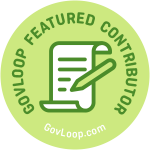You remember the Internet meme that recently took the nation by storm: “Do you hear ‘laurel’ or ‘yanny?’” Here’s a refresher. Depending on what word you heard, it may have been difficult to even fathom how someone else could hear the other term.
“What’s wrong with your ears?” some would decry in the heated debate in households far and wide. As it turns out, there was actual science behind the madness, a clear explanation for the different interpretations of the sound. Unfortunately, though there may have been a scientific explanation for that experiment, communication is not so easily explained.
In fact, communication is more art than science. This is especially important to remember in the workplace. So often, people speak past each other, as if speaking (and hearing) different languages. Employee relations offices across the federal government can attest that communication is the catalyst for many issues that arise in the office. Sometimes the problems are approached with rigidity — take that course, write that down, say that specific thing that way — but the disconnect may persist because again, communication is not a science. People are not robots. Learning how to reach another, learning another’s motivations and insecurities, is a valuable tool for creating a productive environment for work (and for life).
Recently, I was privileged to participate in a fascinating seminar at my workplace that helped to emphasize this idea. Four Lenses is an activity created by Shipley Communication that demonstrates different personality types and how they can effectively co-exist. It is similar to the famous Rorschach psychological test, but it is more team-oriented.
During the seminar, the office workers and managers filled out questionnaires that essentially defined their strongest personality characteristics and subsequently divided them into groups of others with similar personalities distinguished by different colors. There were the nurturing, gregarious “Blues,” the thrill-seeking, mischievous “Oranges,” the organized, if not rigid “Golds,” and the independent, non-conformist “Greens.”
The activity was quite revelatory and left people stunned at how accurate the test seemed. “Oh my, that IS you!” one could periodically hear another say to a colleague throughout the experiment. More importantly, the activity provided a window into how to best communicate with different personality types to create a healthier, more productive work environment and how taking the time to learn this, can be both personally and collectively beneficial. It specifically honed in on three ideas: knowing thyself, knowing others and the importance of continuous improvement.
Knowing thyself
The very first step in managing a relationship is knowing what you bring to the table. Who are you really? What are your motivations? What are your preferences and your intolerances? Being conscious of these things allows you to understand what message you are sending to your colleagues. It also allows you to prepare your colleagues for how to best communicate with you.
Knowing others
Being able to categorize certain personality types is immensely helpful in determining how to respond to others in ways that maximize success and minimize conflict. Even if a conflict arises, recognizing others’ triggers helps navigate a potentially difficult situation into calmer waters.
Continuous improvement
Since the only things certain in life are death and taxes, it is important to recognize that personalities are fluid; circumstances arise that alter perspectives and subsequently how people react to various stimuli. For this reason, it is important to continue to find ways to grow and learn. The Four Lenses seminar stressed that the most evolved person is the one who can relate to each personality color. This means that it is not enough to just know yourself and know others; it is equally important to appreciate the differences and to find common ground where possible. Since that common ground can shift as different issues arise, periodically revisiting the lesson of the Four Lenses can make one more empowered and confident in his or her ability to handle situations involving different personalities.
I highly recommend researching the Four Lenses experiment and conducting it for yourself as well as suggesting it for your workplace. Weeks after my organization participated in the activity, my colleagues were still talking about it, still referencing the lessons, still joking about the different personalities and how easy it was in retrospect to see who fit with what personality color and how and why that person may have reacted to something the way he or she did. The knowledge the activity provided was invaluable. It brought the personal and collective introspection needed to better navigate our office dynamics, and I am certain it can do the same for yours.
You may also find these related articles helpful: Workplace Communication: Another Way to Say No and Workplace Communication Tips
Tamara Key is part of the GovLoop Featured Contributor program, where we feature articles by government voices from all across the country (and world!). To see more Featured Contributor posts, click here.





Great post and I definitely want to check out the Four Lenses experiment. Sounds like an awesome ice breaker or group activity.